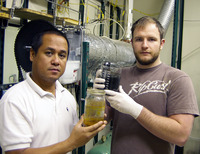Locomotives north of the border will be testing biodiesel to see how well the green fuel works in cold weather conditions.
Canadian Pacific will test four locomotives running on biodiesel on some lines between Calgary and Edmonton:
The pilot project will evaluate the cold weather application of biodiesel in real world conditions. It is the first cold weather use of biodiesel by a railroad. The pilot is a partnership with Natural Resources Canada under the National Renewable Diesel Demonstration Initiative.
 Canadian Pacific will undertake routine detailed mechanical examinations of the locomotives in the pilot project. The information gathered will be used to evaluate whether a biodiesel mixture of up to 5% (B5) has any significant adverse effects on a locomotive or its associated systems in cold weather operation. Impact to reliability, potential changes to the overhaul or maintenance work scope and reviews of specific components on the locomotives will also be monitored.
Canadian Pacific will undertake routine detailed mechanical examinations of the locomotives in the pilot project. The information gathered will be used to evaluate whether a biodiesel mixture of up to 5% (B5) has any significant adverse effects on a locomotive or its associated systems in cold weather operation. Impact to reliability, potential changes to the overhaul or maintenance work scope and reviews of specific components on the locomotives will also be monitored.
This link is supposed to have some video … none there as I post this, but I’ll keep checking, and let you know if there’s anything to see.
UPDATE: The link now has some pretty cool video of the biodiesel-powered locomotives in action. Check it out!


 A $22 million grant … thanks to the federal Stimulus Bill … will help Duke Energy research using batteries to store wind energy from a Texas wind farm.
A $22 million grant … thanks to the federal Stimulus Bill … will help Duke Energy research using batteries to store wind energy from a Texas wind farm.
 “This is a wonderful opportunity to showcase how biodiesel is a green, sustainable part of the solution to meeting America’s energy needs,” said National Biodiesel Foundation Executive Director Tom Verry. The route was specially tailored to allow for easy refueling with biodiesel blends, and public education is planned along the way about the benefits of biodiesel…
“This is a wonderful opportunity to showcase how biodiesel is a green, sustainable part of the solution to meeting America’s energy needs,” said National Biodiesel Foundation Executive Director Tom Verry. The route was specially tailored to allow for easy refueling with biodiesel blends, and public education is planned along the way about the benefits of biodiesel… Brazilian Finance Minister Guido Mantega has confirmed that government will extend tax breaks to flexible fuel vehicles (FFVs) and others that are “environmently friendly”. According to Reuters, the Brazilian government will allow and extension on tax breaks given to E85 compatible cars with 1-liter engines until March of 1010 and trucks until June of 2010. Reversely, taxes on traditional gasoline-powered vehicles will rise in December.
Brazilian Finance Minister Guido Mantega has confirmed that government will extend tax breaks to flexible fuel vehicles (FFVs) and others that are “environmently friendly”. According to Reuters, the Brazilian government will allow and extension on tax breaks given to E85 compatible cars with 1-liter engines until March of 1010 and trucks until June of 2010. Reversely, taxes on traditional gasoline-powered vehicles will rise in December. “We want the automobile industry in Brazil to consolidate and to bring new environmental technologies to the country” Mantega told reporters at a news conference in Brasilia.
“We want the automobile industry in Brazil to consolidate and to bring new environmental technologies to the country” Mantega told reporters at a news conference in Brasilia. 

 On Twitter, many agriculture advocates are taking part in tweeting the hashtag #thankafarmer today from 10 am to 12 pm CST. Twitter users are also expressing their gratitude with a
On Twitter, many agriculture advocates are taking part in tweeting the hashtag #thankafarmer today from 10 am to 12 pm CST. Twitter users are also expressing their gratitude with a  A Massachusetts company is working on developing a cheap catalyst that will separate water molecules to harvest the hydrogen for home use.
A Massachusetts company is working on developing a cheap catalyst that will separate water molecules to harvest the hydrogen for home use.